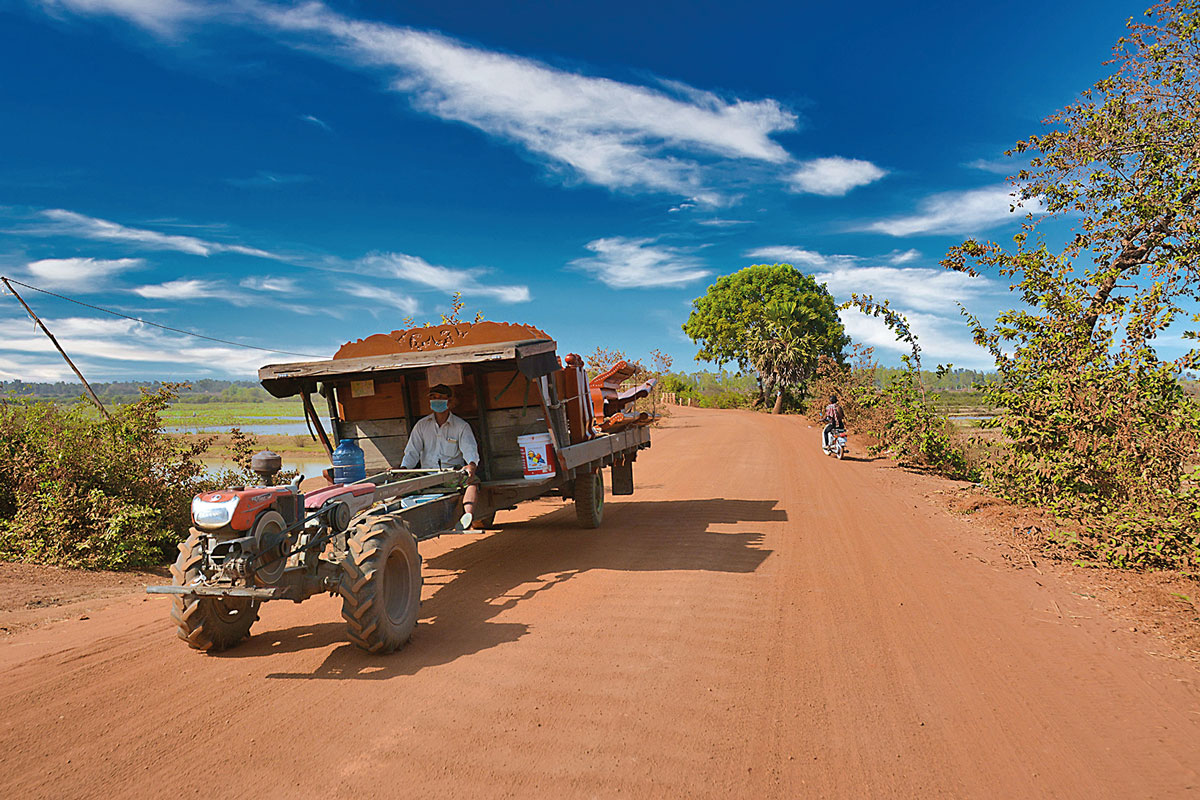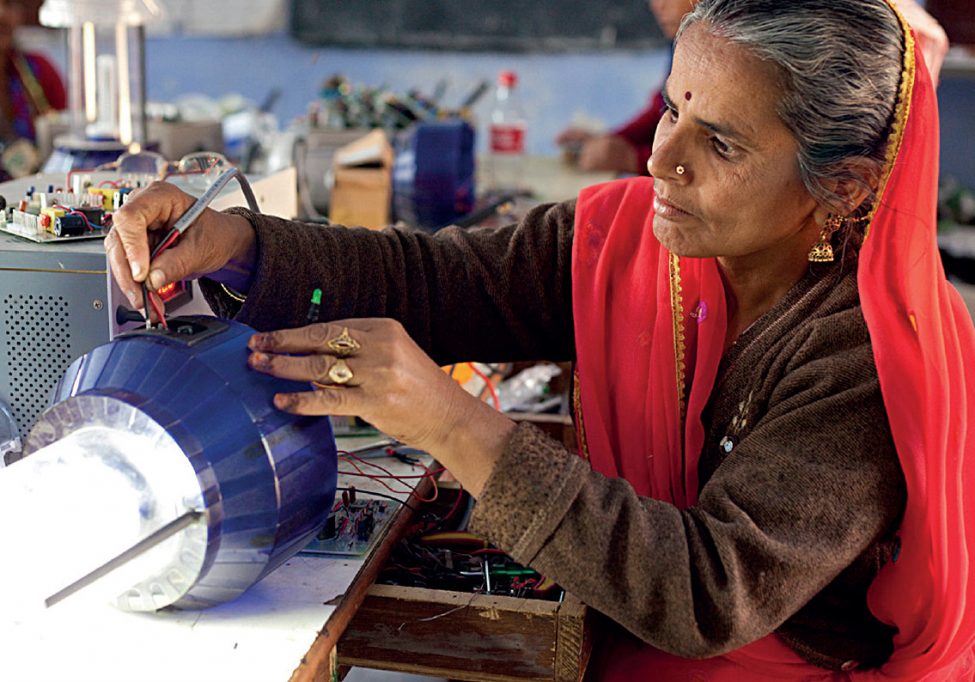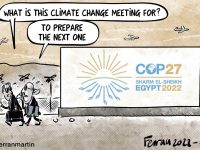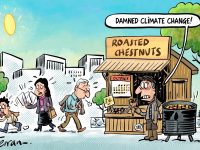COVID-19 and climate change
Challenges or opportunities for economic recovery

The paper reviews the impact that COVID-19 has had on the ambitions of countries to meet the Paris Accord of reducing emissions to keep global temperature increases to below 2 ºC in this century. It notes that as nations recover from the crises, if no additional measures are taken, emissions of greenhouse gases will rise again and return to their old pathway as they did after previous crises. The paper proposes actions in the short and medium terms to build back differently this time and help meet the global climate challenge.
Keywords: economics, climate change, emissions, COVID-19.
The story so far
COVID-19 presents an unprecedented global health and economic crisis. Since detection of the virus at the end of 2019, it has caused around 157 million infections and more than 3.3 million deaths (World Health Organization, 2021). As a result of the measures to contain the virus the global economy entered – to a certain extent – a lockdown, and during this time, emissions declined. The Global Carbon Project (2020) reports a decline in greenhouse gas (GHG) emissions of 7 % in 2020 due to contractions in travel, transport, and energy demand. While this is welcome from a climate change point of view, it has to be seen in context. The 2019 UNEP Emissions Gap Report estimates that, in order to limit global warming to 1.5ºC, emissions will need to continue to fall 7.6 % per annum for the next ten years (United Nations Environment Programme, 2019). These figures show the magnitude of the challenge in decreasing GHG-emissions. The major economic breakdown at global level led to the – short term – reduction of these emissions by an amount we would need for the next ten years. Nobody wants the pandemic and associated movement restrictions to continue for the next ten years to achieve the climate target – we need a very different strategy to achieve the globally agreed targets!
«As a result of the measures to contain the virus the global economy entered a lockdown, and emissions declined»
There is also some evidence that the pandemic-induced drop in emissions may be reversed in the very short run, partly as fear of infection makes people avoid public transport (already partly observed in China, see BloombergNEF, 2020) and as lockdown restrictions are relaxed. In early April 2020, daily fossil fuel emissions worldwide were roughly 17 % lower than they were in 2019, as governments ordered people to stay home, employees stopped driving to work, factories idled, and airlines grounded their flights (Le Quéré, Jackson, Jones, Smith, Abernethy, Andrew, De-Gol, Willis et al., 2020). But by mid-June 2020, as countries eased their lockdowns, emissions had ticked up to just 5 % below the 2019 average, the authors estimated in an update (Le Quéré, Jackson, Jones, Smith, Abernethy, Andrew, De-Gol, Shan, Canadell et al., 2020). Emissions in China, which accounts for one-quarter of the world’s carbon pollution, appear to have returned to pre-pandemic levels. The study’s authors said they were surprised by how quickly emissions had rebounded. But, they added, any drop in fossil fuel use related to the coronavirus was always likely to be temporary unless countries took concerted action to clean up their energy systems and vehicle fleets as they moved to rebuild their ailing economies.

The global economic breakdown from COVID-19 led to the short term reduction of greenhouse gas emissions by an amount we would need for the next ten years. But there is also some evidence that this drop may be reversed in the very short run. / Rawpixel
At the same time, the COVID-19 crisis has shown some new pathways for a transition to a low carbon future. The decline in travel has not necessarily meant a less productive work force; indeed, time saved travelling to work is put to good use while also reducing carbon emissions according to a survey of 1,000 companies conducted in the UK (BBC, 2020). The stresses on food systems caused by problems of transporting food and the restrictions on food exports introduced by some countries has drawn attention to alternative local supply networks that have a lower carbon footprint. Vacations that were becoming increasingly dependent on long distance air travel have had to be curtailed, substituted in part by «staycations» and the opening of new opportunities closer to home. All this will not remain the same as the pandemic comes to an end, but some of the seeds sown during the lockdowns and restrictions can form the basis of new patterns of behaviour that are less carbon intensive. In this note we discuss some ways in which we can promote such a shift through changes in behaviour and other measures.
What we need to do
The path going forward
The pandemic has shown us that, while countries have differed in the effectiveness of their response, in the long run national borders cannot contain the problem and they are practically irrelevant to global issues like health, food security, and sustainability. Rather than following traditional approaches for international development, the path forward should be for global development that relies upon multi-scale analyses and identifies problematic dynamics between countries larger and smaller, richer and poorer (Oldekop et al., 2020). The path should also prioritise support for companies and agencies that will advance a resilient and economically just recovery (Stiglitz, 2020).
«Nobody wants the pandemic to continue for the next 10 years to achieve the climate target: we need a very different strategy»
The path for going forward has to plan and execute actions over the short term, covering the next year; as well as deeper changes in the medium term that alter human behaviour and the structures that engender production and consumption to meet the sustainable development goals (SDGs) set up in the UN’s 2030 Agenda. There are real opportunities to plan a better recovery which sets the basis of a cleaner economic development in coming years. What we consider to be some key components are highlighted below.
Actions in the short term
In the past, fiscal recovery following previous crises has tended to be carbon-intensive and not pay much attention to other environmental concerns. In 2009 the financial crises caused CO2 emissions to fall by 1.4 % but the following year they increased by 5.1 %, much more than the rate of increase prior to the crises (Borghesi, 2020).
To restart the economy, governments turn to sectors where investments can be made easily and often these are carbon-intensive, such as construction and airlines. To avoid this, fiscal stimulus should be directed towards actions that decouple economic activity from carbon emissions and biodiversity loss and transform the economy for the long-run. There is a risk that a recession could reduce investment in innovation for sustainability, and that increased poverty could prioritize cheapest, short-run benefits. Another risk to be avoided is related to investment in assets that yield high short term returns but become stranded when carbon emission constraints bite more forcefully.
«One reason for optimism is the potential for building on changes in behaviour that have been observed during the crises»
The OECD notes that, at the very least, measures taken for recovery should be checked against a «do no harm» criterion with respect to the environment (Agrawala et al., 2020). But more can be expected from governments, even in the short term. Natural capital investment for ecosystem resilience and regeneration, including restoration of carbon-rich habitats and climate-friendly agriculture, have been identified by researchers at Oxford University as having a long-run multiplier and strongly positive impact on climate (Hepburn et al., 2020). Environmental economists from Colorado State University point to three key no-cost policies that would support progress towards several of the SDGs and provide incentives for long-term sustainable development: fossil fuel subsidy swaps, irrigation subsidy swaps and a carbon tax to benefit less developed countries (Barbier, 2020). Others investments that would hard-wire sustainability include: clean energy infrastructure, clean connectivity infrastructure (e.g. low carbon mobility), general R&D spending, clean energy R&D spending, and spending on education. Faced with the COVID-19 recession, governments do not need to compromise economic priorities for the sake of environmental ones. By carefully designing low-carbon stimulus packages, they can address both sets of priorities at once. There is a growing and influential community in the corporate sector that supports such measures. And investments in sustainable development support the creation of a green economy.
The selection of green stimulus packages needs to consider the trade-off between the short term multiplier effects and the implication of the measures for longer term sustainable growth. Account also needs to be taken of the extent of the «green» benefits. Strand and Toman (2010) note that activities with the greatest potential immediate stimulus effects (in particular, for employment in the short run) often seem to have less favourable growth effects. Conversely, a number of activities with strong long-term impacts on growth and welfare are likely to have more limited short-run stimulus effects. However, environmental clean-up, sustainable agriculture investments, natural resource safeguarding, and improving energy efficiency generally could have positive stimulus effects in the short run, as well as environmental effects in the longer run. Programs with both short term stimulus and longer term gains are improved energy efficiency, reduced congestion, sustainable, resilient food systems, and energy-saving changes in urban structure; they can improve growth and at the same time reduce GHG emissions.
Strand and Toman review actual stimulus packages instituted in 2009 across a range of countries and find hardly any of the ones in developing countries had a significant green component. Programs that could be implemented in the present crises in countries with strong stimulus measures include energy efficiency measures in buildings (weather-proofing) and in agriculture, which could yield significant cost savings and also be relatively labour intensive. The same applies to upgrading of power transmissions systems which allow for reduced losses of given power. There has been a shift in patterns of energy consumption that require some adjustment on the supply side. Buildings sector energy consumption profiles for example, have changed during the COVID19 pandemic as has energy demand by data centres and networks. As a result, many non-residential buildings also need to adapt their energy operation schedules from full-space to partial-space operations, which is not always possible with existing control strategies. The energy impacts of these unprecedented changes – and whether they will be sustained after the crisis – have yet to be determined (IEA, 2020).
The potential of green investments in general is huge. As the International Resource Panel (2020) notes improvements of 60–80 % in energy and water efficiency are technically possible and commercially viable globally in sectors such as construction, agriculture, food, industry, and transport. This can deliver cost savings of $2.9–3.7 trillion per year by 2030. Investing some $900 billion could potentially generate 9–25 million jobs. Access to financing to undertake such investments, however, especially where they also address other environmental and social goals, will remain a challenge.
Changes in the medium term
Prospects for structural change
Fortunately, the discourse on the post-COVID future, while recognizing the immense challenges the world faces, is also positive about the prospects of rebuilding better during the coming years. Decoupling economic activity from greenhouse gas emissions requires both technological innovation and policies that incentivize renewable energy, energy efficiency, and service-based industries, and de-incentivize energy intensive sectors. Governments, international agencies and researchers all view the crisis as something that can serve as a turning point to accelerate decoupling and the transition to a low carbon future; to rebalance and transform our economies in ways that make them more inclusive, sustainable and resilient; and more generally increase our efforts to meet the SDGs.
One reason for optimism is the potential for building on changes in behaviour that have been observed during the crises. As noted in the introduction, there has been rapid adaptation to working remotely, improvements in technology, and an appreciation of the benefits. As economies reopen, one may expect a partial return to pre-crisis normal, but behaviour will also change permanently. One speculative estimate is that up to one-third of the global workforce will sustain remote working practices at least part-time (Global Workplace Analytics, 2020). This can be supported by measures to make home offices more digitally efficient.
The other reason for being optimistic is the strong public support for a change in direction, including in the corporate sector. For example, 206 major firms have written to the UK government urging for an economic recovery plan that prioritises climate action. Companies such as Mitsubishi, Coca-Cola, Unilever, and Siemens have signed in support. Other notable signatories include a number of firms working in carbon-intensive sectors such as BP, cement producer CEMEX, Heathrow Airport, and Shell (Costa Figueira, 2020).
The shift in thinking on how the recovery can advance the green agenda can be seen in the discussions ongoing inside the EU. At a meeting on 23rd June, 2020, Ministers identified priorities for investments that create or maintain jobs, stimulate the economy, and achieve steeper emission reductions of around 55 % by 2030 compared to the 2014 target of 40 %. European leaders negotiated the final shape of the recovery funding and EU budget for 2021–2027 over the summer with the task of both stimulating the economy and achieving steeper emission reductions. The technologically and economically viable options for meeting the higher target have improved considerably since 2014. Technological advancements on power and road transport and a rapid fall in costs of wind and solar power mean that an increase of the 2030 climate target of up to 65 % is within reach (Hainsch et al., 2020). Already 96 % of operating coal capacity in the EU costs more than renewables and COVID-19 has worsened the economic difficulties of coal. Underlying the green agenda is a shift away from conventional growth as the guiding principle of policy, towards one that seeks to promote green and sustainable growth.
Promoting low carbon lifestyles
The potential for a more rapid transition to a low carbon economy and society, and the impetus it gets from the pandemic, has already been noted. Moreover, in light of a rapidly changing external environment, the transition must put resilience of institutions and society to future shocks at its centre.
It is essential to build on these positive forces for a better future. The extent to which behavioural adaptations become embedded post-crisis will be affected by policy choices during the recovery period, as well as the extent and severity of lockdown measures. To a large extent the actions need to reinforce the excellent work that governments and international agencies have been doing to promote the low carbon transition, the move to sustainable food systems, and other SDGs.

Environmental clean-up, sustainable agriculture investments, natural resource safeguarding, and improving energy efficiency generally could have positive stimulus effects in the short run, as well as environmental effects in the longer run. Above, women training for solar engineering in India. On the left, woman participating in an irrigation project in Mozambique. / UN Women/Gaganjit Singh
One key difficulty in implementing the transition to a resilient low carbon society so far has been the issue of economic justice: those engaged in carbon intensive sectors who lose out from the transition may be few relative to those who gain but they are often vulnerable and options for alternative livelihoods are not easy to find. COVID-19 has pushed millions out of work and unemployment will be a key indicator during the recovery. Moreover, the pandemic has increased economic and health inequality within countries (Blundell et al., 2020) and between rich and poor countries (as has been the case with past epidemics) (Furceri et al., 2020). The changes in these effects include a) employment impacts that are more severe for lower income and lower education groups, and b) increased debt for low-income households while better-off households are actually increasing savings.
«Programs with both short term stimulus and longer term gains can improve growth and at the same time reduce emissions»
The implication of these aspects on policies that are implemented in pursuit of a low carbon economy is that they have to be mindful of their distributional effects. One example is promoting home working to reduce transport-related emissions. Research has shown that the share of employment that can be done from home varies significantly with countries’ incomes: in urban areas, this share is only about 20 % in poor countries, compared to close to 40 % in rich ones. This result is largely driven by the prevalence of self-employed workers in low-income countries. They further show that educational attainment, formal employment status, and household wealth are positively associated with the possibility of working from home, reflecting the vulnerability of various groups of workers (Gottlieb et al., 2020). Hence measures that encourage home working will need to be complemented with those that improve access to the infrastructure that makes this possible.
A second policy that could be promoted to reduce GHG emissions is to buy locally and not from places that involve long distance transport. But for developing countries that export fresh produce, including fruits, vegetables and flowers, such a policy could be devastating; moreover, it may not reduce emissions when account is taken of all life cycle emissions. Food system investments should follow the results of life-cycle assessments and economic impact analyses. Third, there has been a major labour shock from the pandemic. Green industries will not be able to hire unemployed workers unless there is a strong programme of retraining and relocation.
In summary, economic recovery from the pandemic offers a unique opportunity to transform our energy-intensive economy. Short-term stimulus and medium-term policies need to sit in a framework that accounts for long-term implications to the climate and sustainable development goals, decouples economic activity from energy consumption, and address the inequalities and injustices that have emerged during the crises and that will emerge during a post-COVID transition.
References
Agrawala, S., Dussaux, D., & Monti, N. (2020). What policies for greening the crisis response and economic recovery? Lessons learned from past green stimulus measures and implications for the COVID-19 crisis. OECD Environment Working Papers, 164. https://doi.org/10.1787/c50f186f-en
Barbier, E. B. (2020) Greening the post-pandemic recovery in the G20. Environmental and Resource Economics, 76, 685–703. https://doi.org/10.1007/s10640-020-00437-w
BBC. (2020, October 5). Home working here to stay, study of businesses suggests. BBC News. https://www.bbc.co.uk/news/business-54413214
BloombergNEF. (2020, May 13). Gridlock in Beijing as Communiter Shun Public Transport. Bloomberg NEF. https://about.bnef.com/blog/gridlock-in-beijing-as-commuters-shun-public-transport/
Blundell, R., Joyce, R., Costa Dias, M., & Xu, X. (2020, June 11). Covid-19: The impacts of the pandemic on inequality. Institute for Fisical Studies. Retrieved October 9, 2020, from https://www.ifs.org.uk/publications/14879
Borghesi, S. (2020, April 8). COVID-19, climate policy and carbon markets. LIFE DICET project. https://lifedicetproject.eui.eu/2020/04/08/covid-19-climate-policy-and-carbon-markets/
Costa Figueira, J. (2020, June 2). Over 200 British firms urge government to align economic recovery with net zero goal. Climate Action. https://www.climateaction.org/news/over-200-british-firms-urge-government-to-align-economic-recovery-with-net
Furceri, D., Loungani, P., Ostry, J. D., & Pizzuto, P. (2020, May 8). COVID-19 will raise inequality if past pandemics are a guide. VoxEU. https://voxeu.org/article/covid-19-will-raise-inequality-if-past-pandemics-are-guide
Global Carbon Project. (2020). Carbon budget 2020. An annual update of the global carbon budget and trends. https://www.globalcarbonproject.org/carbonbudget/
Global Workplace Analytics. (2020). Work-at-home after COVID-19–Our forecast. https://globalworkplaceanalytics.com/work-at-home-after-covid-19-our-forecast
Gottlieb, C., Grobovšek, J., Poschke, M., & Saltiel, F. (2020). Working from home: Implications for developing countries. In S. Djankov & U. Panizza (Eds). COVID-19 in developing economies. CEPR Press. https://voxeu.org/content/covid-19-developing-economies
Hainsch, K., Brauers, H., Burandt, T., Göke, L., Von Hirschhausen, C., Kemfert, C., Kendziorski, M., Löffler, K., Oei, P.-Y., Präger, F., & Wealer, B. (2020). Make the European Green Deal real – Combining climate neutrality and economy recovery. Deutsches Institut für Wirtschaftsforschung.
Hepburn, C., O’Callaghan, B., Stern, N., Stiglitz, J., & Zenghelis, D. (2020). Will COVID-19 fiscal recovery packages accelerate or retard progress on climate change? Oxford Review of Economic Policy, 36(1), S359–S381. https://doi.org/10.1093/oxrep/graa015
IEA (2020). The Covid-19 crisis and clean energy progress. In Tracking clean energy process. IEA. https://www.iea.org/reports/the-covid-19-crisis-and-clean-energy-progress/buildings
International Resource Panel. (2020). Building resilient societies after the COVID-19 pandemic. Key messages from the International Resource Panel. UN Environment Programme. https://www.resourcepanel.org/sites/default/files/documents/document/media/building_resilient_societies_after_the_covid-19_pandemic_-_key_messages_from_the_irp_-_12_may_2020.pdf
Le Quéré, C., Jackson, R. B., Jones, M. W., Smith, A. J. P., Abernethy, S., Andrew, R. M., De-Gol, A. J., Willis, D. R., Shan, Y., Canadell, J. G., Friedlingstein, P., Creutzig, F., & Peters, G. P. (2020a). Temporary reduction in daily global CO2 emissions during the COVID-19 forced confinement. Nature Climate Change, 10, 647–653. https://doi.org/10.1038/s41558-020-0797-x
Le Quéré, C., Jackson, R., Jones, M., Smith, A., Abernethy, S., Andrew, R., De-Gol, A., Shan, Y., Canadell, J., Friedlingstein, P., Creutzig, F., & Peters, G. (2020b). Supplementary data to: Le Quéré et al (2020), Temporary reduction in daily global CO2 emissions during the COVID-19 forced confinement (Version 1.3). Global Carbon Project. https://doi.org/10.18160/RQDW-BTJU
Oldekop, J. A., Horner, R., Hulme, D., Adhikari, R., Agarwal, B., Alford, M., Bakewell, O., Banks, N., Barrientos, S., Bastia, T., Bebbington, A. J., Das, U., Dimova, R., Duncombe, R., Enns, C., Fielding, D., Foster, C., Frederiksen, T., Gao, P. … Zhang, Y. (2020). COVID-19 and the case for global development. World Development, 134, 105044. https://doi.org/10.1016/j.worlddev.2020.105044
Stiglitz, J. (2020, 2 de julio). Invest in the green economy and we’ll recover from the Covid-19 crisis. The Guardian. https://www.theguardian.com/business/2020/jul/02/invest-in-the-green-economy-and-well-recover-from-the-covid-19-crisis
Strand, J., & Toman, M. (2010). “Green stimulus”, economic recovery, and long-term sustainable development. Policy Research Working Paper; No. 5163. World Bank. https://openknowledge.worldbank.org/handle/10986/19956
United Nations Environment Programme. (2019). Emissions gap report 2019. UNEP. https://wedocs.unep.org/bitstream/handle/20.500.11822/30797/EGR2019.pdf?sequence=1&isAllowed=y
World Health Organization. (2021). WHO Coronavirus Disease (COVID-19) Dashboard. WHO Health Emergency Dashboard. Retrieved May 10th, 2021, from https://covid19.who.int/





